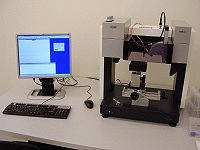Specific Process Knowledge/Characterization/Drop Shape Analyzer: Difference between revisions
Appearance
| Line 30: | Line 30: | ||
|style="background:LightGrey; color:black"|Available liquids | |style="background:LightGrey; color:black"|Available liquids | ||
|style="background:WhiteSmoke; color:black"| | |style="background:WhiteSmoke; color:black"| | ||
*Syringe 1: Water ( | *Syringe 1: Water (H<sub>2</sub>O) | ||
*Syringe 2: Diiodo-methane ( | *Syringe 2: Diiodo-methane (CH<sub>2</sub>I<sub>2</sub>) | ||
*Syringe 3: Benzyl alcohol ( | *Syringe 3: Benzyl alcohol (C<sub>6</sub>H<sub>5</sub>CH<sub>2</sub>OH) | ||
*Syringe 4: Available | *Syringe 4: Available | ||
*Manual dispense is also possible | *Manual dispense is also possible | ||
| Line 44: | Line 44: | ||
|style="background:LightGrey; color:black"|Substrate size | |style="background:LightGrey; color:black"|Substrate size | ||
|style="background:WhiteSmoke; color:black"| | |style="background:WhiteSmoke; color:black"| | ||
*Up to 6" wafers. In order to measure, a few | *Up to 6" wafers. In order to measure, a few mm<sup>2</sup> of flat surface is required. | ||
|- | |- | ||
|style="background:silver; color:black"| | |style="background:silver; color:black"| | ||
Revision as of 13:45, 11 May 2017
Feedback to this page: click here
The Drop Shape Analyzer

The Krüss DSA 100S Drop Shape Analyzer will analyze the shape of a drop of liquid on a surface, or suspended from a needle, in order to calculate the contact angle, or the surface tension, respectively. It is mostly used to determine the contact angle of water as a measure of the hydrophobicity/hydrophility of the sample surface.
The user manual, user APV(s), technical information, and contact information can be found in LabManager:
Drop Shape Analyzer in LabManager
An overview of the performance of the Drop Shape Analyzer
| Purpose | Imaging and analysis of of the shape of the interface between liquid and air |
|
|---|---|---|
| Performance | Measurement accuracy |
|
| Process parameters | Available liquids |
|
| Sample requirements | Substrate material allowed |
|
| Substrate size |
| |
| Batch size |
|
